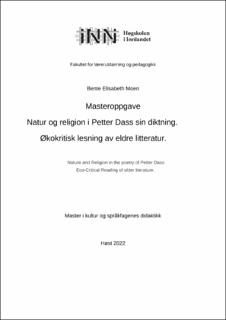| dc.contributor.advisor | | |
| dc.contributor.author | Moen, Bente Elisabeth | |
| dc.date.accessioned | 2023-04-24T16:11:13Z | |
| dc.date.available | 2023-04-24T16:11:13Z | |
| dc.date.issued | 2022 | |
| dc.identifier | no.inn:inspera:121652214:31133227 | |
| dc.identifier.uri | https://hdl.handle.net/11250/3064621 | |
| dc.description.abstract | Denne oppgaven omhandler en studie av Petter Dass (1647-1707). Jeg har valgt to ulike dikt av samme forfatter for å undersøke om religion og natur har lik eller ulik betydning. Hans dikt kan dermed brukes både i norskfaget og i KRLE, og i skolens tverrfaglige tema som bærekraftig utvikling, demokrati og medborgerskap og helse og livsmestring.
Jeg analyserer og drøfter om Petter Dass formidling i det religiøse diktet "Den Første Sang" under "Den Apostoliske Troes Article. Forfattede i Tolv Sange" stemmer overens med hans natursyn i det topografiske diktverket Nordland´s Trompet. Det vil si om hans grunnleggende natursyn og erfaring er i overensstemmelse med hans religiøse undervisning og hans livssyn.
Jeg finner i analysen at Dass sin religion og livssyn influerer på hans menneske og samfunnssyn, men at han i forhold til naturen er både pragmatisk og moderne i spørsmål som har med naturfenomener og moderne naturvitenskap. Derfor underordnes ikke naturen religionen på en entydig måte i hans diktning. Bibelen gir ham livssyn, men når det gjelder naturen er han en moderne tenker opptatt av erfaring og verifiserbar kunnskap. Det viser hans beskrivelse av malstrømmen i Nordland`s Trompet.
Der ordet "Vey" betyr en konkret vei eller retning i Nordland`s Trompet, mener han med det samme ordet "Guds vei" i katekismesangen "Den Første Sang". "Himmel" i det religiøse diktet er ikked et samme som "Himmel, stjerner, sol og måne" i det topografiske. Det religiøse og det topografiske diktet bruker derfor samme ord, men med forskjellig betydning, ifølge min konklusjon. | |
| dc.description.abstract | This thesis deals with a study of Petter Dass (1647-1707). I have chosen two different poems by the same author to investigate whether religion and nature have similiar or different meanings. His poems can be relevant both in the Norwegian subject and in KRLE, and in the school´s interdisciplinary topics such as sustainable development, democracy and citizenship, and health and life skills.
I analyze and discuss about Petter Dass´ dissemination in the religious poem "The First Song" under "The Apostolic Faith Article. Authored in Twelve Songs" is consistent with his view of nature in the topographical poem Nordland`s Trumpet. That is, whether his basic views of nature and experience are consistent with his religious teachings and his beliefs.
I find in the analysis that Dass`s religion and worldview influence his man and social views, but that in relation to nature he is both pragmatic and modern in questions related to natural phenomena and modern science. Therefore, nature is not subordinate to religion in his poetry. The Bible gives him a view of life, but when it comes to nature, he is a modern thinker concerned with experience and verifiable knowledge. His modernity shows in his description of the maelstrom in Nordland`s Trumpet.
Where the Norwegian word "Vey" means a concrete path or direction in Nordland`s Trumpet, he means by the same word "God`s way" in the catechism song "The First Song". The "Sky" in the religious poem is not the same as "Sky, stars, sun and moon" in the topographic. The religious and topographical poems therefore use the same words, but with different meanings, according to my conclusion. | |
| dc.language | | |
| dc.publisher | Inland Norway University | |
| dc.title | Natur og religion i Petter Dass sin diktning.
Økokritisk lesning av eldre litteratur. | |
| dc.type | Master thesis | |
